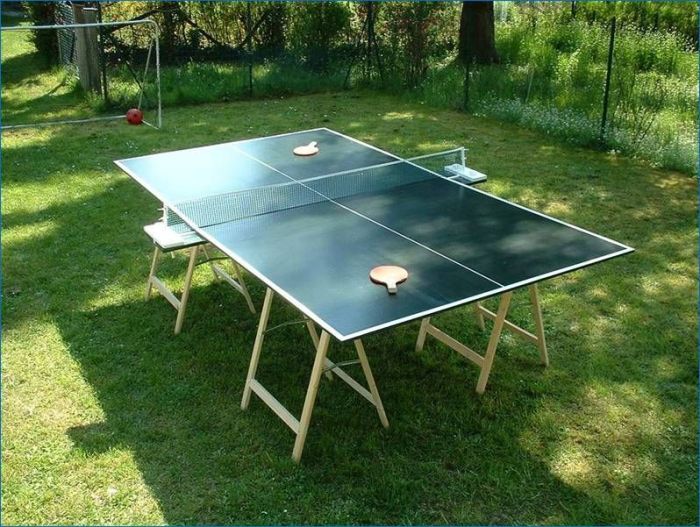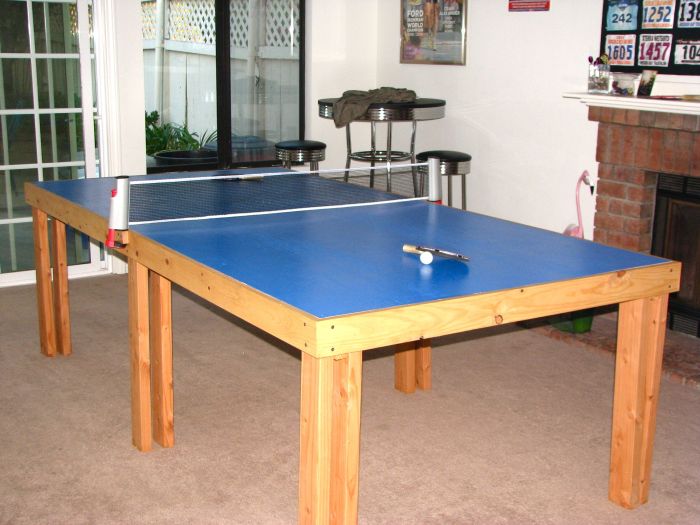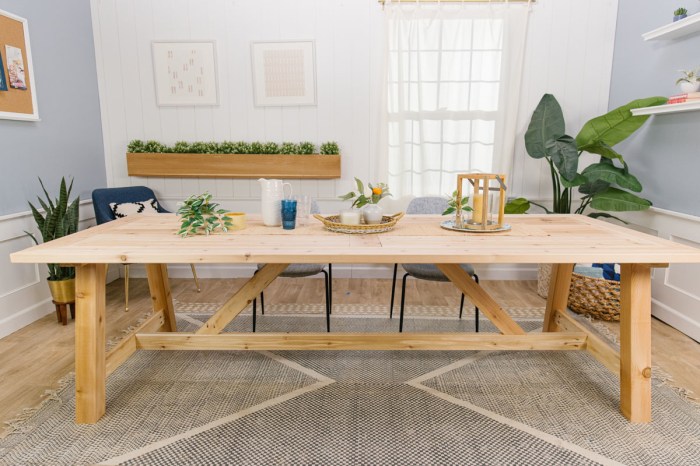DIY tennis table takes center stage, inviting you to craft your own court with a blend of skill and creativity. Building a DIY tennis table is a rewarding project that allows you to design a table that perfectly fits your space and style. Whether you’re looking for a classic design or a more unique creation, this guide will provide you with the knowledge and inspiration to build a table that you can enjoy for years to come.
From selecting the right materials to mastering the construction process, we’ll cover every step of the journey. We’ll also explore different design options, budget considerations, and essential maintenance tips. Get ready to embark on a fun and fulfilling DIY adventure.
Introduction to DIY Tennis Tables

Building your own tennis table can be a rewarding and cost-effective project. You’ll have the satisfaction of creating a custom-made table that meets your specific needs and preferences, while potentially saving money compared to purchasing a pre-made one.
DIY tennis table projects offer a wide range of possibilities, allowing you to personalize your table in various ways. You can explore different designs, materials, and features to create a table that fits your space, style, and budget.
Types of DIY Tennis Table Projects
DIY tennis table projects can be categorized based on the materials used and the design approach. Here are a few popular types:
- Reclaimed Materials: This approach utilizes salvaged or repurposed materials like wood pallets, old doors, or even discarded furniture to create a unique and eco-friendly table. It’s a great way to give new life to old items and reduce waste.
- Minimalist Designs: Minimalist DIY tennis tables prioritize simplicity and functionality. These tables often use basic materials and construction techniques, resulting in a sleek and modern look. They can be a great option for smaller spaces or those seeking a clean aesthetic.
- Customizable Designs: This category encompasses projects that allow you to personalize your table’s features, such as adding storage compartments, adjustable legs, or unique playing surfaces. You can tailor the design to your specific needs and preferences.
Choosing the Right Materials and Tools
The materials and tools you need for your DIY tennis table project will depend on the design and complexity of your chosen plan. Here are some general guidelines:
- Wood: Plywood is a popular choice for tennis table tops due to its stability and affordability. Consider using marine plywood for added durability, especially if your table will be exposed to the elements.
- Legs: You can use sturdy wooden legs, metal pipes, or even repurposed furniture legs for your table. Ensure the legs are strong enough to support the weight of the table and players.
- Hardware: You’ll need screws, bolts, brackets, and other hardware to assemble your table. Choose high-quality hardware for long-lasting durability.
- Tools: Basic woodworking tools like a saw, drill, screwdriver, and measuring tape are essential. You may also need specialized tools depending on your project’s complexity.
Finishing Touches

Now that your tennis table is structurally sound and ready for use, it’s time to add some finishing touches to make it truly your own. This is where you can get creative and express your personal style, transforming your DIY project into a unique and eye-catching centerpiece.
Decorative Elements
Adding decorative elements can elevate your tennis table from functional to fantastic. There are countless ways to personalize your table, from simple accents to intricate designs.
- Tabletop Designs: You can create a unique look by adding a design to the playing surface. This could be a simple border, a complex pattern, or even a custom logo. Stencils are a great way to achieve intricate designs, while freehand painting allows for more artistic freedom.
- Leg Decoration: The legs of the table offer another opportunity for personalization. You could paint them a bold color, wrap them in decorative tape, or even add decorative accents like wood carvings or metal embellishments.
- Net Posts: Don’t forget the net posts! These can be painted, wrapped, or adorned with decorative elements to match the overall design of your table.
Applying Finishes
Once you’ve decided on your decorative elements, it’s time to apply the finishing touches. The type of finish you choose will depend on the materials you used for your table and the desired look.
- Paint: Paint is a versatile option for adding color and protection to your table. You can choose from a wide range of colors and finishes, including gloss, matte, and satin. Before painting, ensure the surface is clean and properly prepared.
- Stain: Stain is a great way to enhance the natural beauty of wood. It adds color and depth without obscuring the wood grain. Apply stain evenly, following the manufacturer’s instructions.
- Other Finishes: Other finishing options include varnishes, polyurethanes, and waxes. These provide a protective layer and enhance the look of your table. Varnishes and polyurethanes are durable and offer excellent protection against scratches and water damage. Waxes provide a more subtle finish and are often used on top of other finishes.
Protecting the Table
A well-finished tennis table will last for years to come. However, it’s important to take steps to protect it from wear and tear.
- Covering: A table cover is essential for protecting your table from dust, dirt, and scratches. You can find covers specifically designed for tennis tables, or use a general-purpose cover.
- Regular Cleaning: Regularly clean your table with a damp cloth to remove dust and dirt. Avoid using harsh chemicals or abrasive cleaners that could damage the finish.
- Proper Storage: When not in use, store your table in a dry, cool place. This will help prevent warping and damage from moisture and temperature fluctuations.
Budgeting and Cost Considerations
Building a DIY tennis table can be a fun and rewarding project, but it’s essential to factor in the costs involved before you begin. This section will help you understand the different expenses associated with the project and provide tips for minimizing your overall costs.
Estimating Material Costs
To estimate the cost of materials, consider the size and design of your tennis table. Here are some common materials and their estimated costs:
- Plywood: A standard tennis table requires approximately 12-15 sheets of 3/4″ plywood, costing between $25-$40 per sheet. This is a significant expense, so choosing a lower-cost plywood option might be a good idea, but it’s crucial to ensure it’s sturdy enough for the table’s weight and use.
- Lumber: You’ll need 2x4s or 2x6s for the table’s frame and legs, costing around $5-$10 per board, depending on the length and quality.
- Paint or Stain: The cost of paint or stain will depend on the size of the table and the type of finish you choose. A gallon of quality exterior paint can range from $25-$50, while a quart of stain can cost $10-$20.
- Net and Posts: A tennis net and posts can cost between $20-$50, depending on the quality and brand.
- Hardware: This includes screws, nails, brackets, and other fasteners. A hardware budget of $20-$30 should be sufficient.
Finding Affordable Materials
- Check Local Lumberyards: Lumberyards often offer better prices than big box stores. Ask about sales or discounts on specific types of wood.
- Look for Used or Salvaged Materials: Check local salvage yards or online marketplaces for discounted plywood or lumber. You can also use repurposed materials like pallets or old doors to create a unique and cost-effective table.
- Consider Alternative Materials: Instead of using traditional plywood, explore options like MDF or particleboard, which can be more affordable. Ensure the material is strong enough to support the table’s weight.
Saving Money on Tools
- Borrow or Rent Tools: Many tools are available for rent at hardware stores or tool rental companies. This can save you money compared to buying new tools you may only use once.
- Use Tools You Already Own: Before purchasing new tools, take inventory of what you already have. You might be surprised at how many tools you already own that can be used for this project.
Saving Money on the Overall Project
- Plan Ahead: Thorough planning helps avoid mistakes and unnecessary expenses. Create a detailed shopping list and consider the overall design and construction before purchasing materials.
- Consider a Simpler Design: A more complex design may require more materials and tools, increasing the cost. A simpler design can save you time and money.
- Do Your Research: Compare prices from different suppliers and explore different materials and tools to find the most cost-effective options.
Community and Sharing

Building a DIY tennis table is a rewarding experience, and it’s even better when you can connect with other enthusiasts. Sharing your journey, learning from others, and contributing to a community of DIYers can make the process more enjoyable and successful.
The internet provides a vast platform for connecting with like-minded individuals. Engaging with others can help you overcome challenges, discover new techniques, and find inspiration for your project.
Sharing Your Project
Sharing your DIY tennis table project can inspire others and showcase your creativity. There are many ways to share your work, such as:
- Online Forums: Participate in online forums dedicated to DIY projects, woodworking, or tennis. Share your progress, ask questions, and offer advice to others.
- Social Media: Post photos and videos of your project on social media platforms like Instagram, Facebook, or Pinterest. Use relevant hashtags to connect with a wider audience.
- Blogs and Websites: Create a blog or website to document your project, share tips, and connect with readers.
Asking Questions and Seeking Advice
When you encounter challenges or have questions during your DIY tennis table construction, seeking advice from experienced builders can be invaluable. Online forums and social media groups offer a platform for asking questions and receiving guidance from others who have already built their own tables.
- Specific Questions: Frame your questions clearly and concisely, providing details about your project and the specific challenges you’re facing.
- Include Photos: Attach photos or videos to your questions to help others understand the issue you’re facing.
- Be Patient: It may take some time to receive responses, but be patient and persistent in your search for answers.
Sharing Tips and Tricks, Diy tennis table
Sharing your knowledge and experience can help others avoid common mistakes and achieve successful results.
- Document Your Process: Create a detailed guide or tutorial that Artikels the steps involved in building a DIY tennis table. Include photos, diagrams, and explanations for each stage.
- Share Your Lessons Learned: Highlight any challenges you encountered and the solutions you found. This can help others avoid similar pitfalls.
- Offer Support and Encouragement: Provide constructive feedback and encouragement to others who are working on their own DIY tennis table projects.
With a little planning, effort, and perhaps a dash of creativity, you can transform your backyard or basement into a tennis haven. Building your own DIY tennis table is a rewarding experience that allows you to create a piece of furniture that’s both functional and unique. So, gather your tools, embrace the challenge, and get ready to enjoy hours of fun with your family and friends on your very own DIY tennis table.
Building a DIY tennis table is a fun and rewarding project, especially if you’re looking for a way to bring some fun to your backyard. While you’re working on your table, why not take a break and try your hand at a DIY pumpkin wreath ? It’s a great way to add some fall flair to your home, and you can use the same skills you learned from building your tennis table to create a beautiful and unique wreath.
Once you’re back to your tennis table project, you’ll have a fresh perspective and be ready to tackle the next step.
